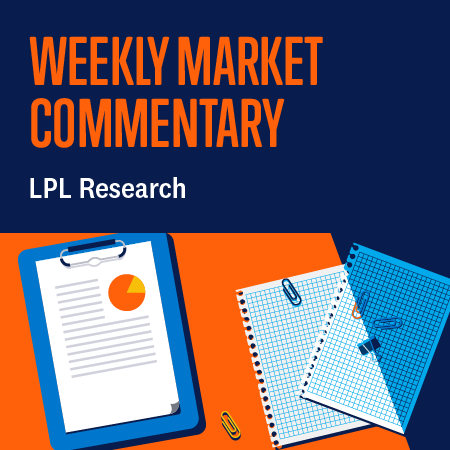To say 2023 was challenging may be an understatement. While stocks had a surprisingly impressive year, there was no shortage of obstacles for investors to overcome, including historic interest rate volatility, recession risk, banking sector turmoil, and a game of monetary policy chicken played between the markets and the Federal Reserve (Fed). LPL Research had some wins and some losses as the market delivered its usual dose of humility to us and many market participants. In an effort to maintain accountability and learn from our mistakes (and hopefully not repeat them), we are starting the new year with our traditional lessons learned commentary.
Following the Federal Reserve’s (Fed) aggressive rate-hiking campaign in 2022 and 2023, stocks are entering a phase in which the market narrative is focused on interest-rate stability — as inflation, we believe, comes down further. Low and stable interest rates should help support stock valuations, while corporate profits are moving into a sweet spot. So even though stocks look fully valued, if rates ease as we expect, we could see upside to our year-end 2024 fair-value target range of 4,850 to 4,950. We highlight some key themes for stocks next year.
Despite a heavy lobbying effort to cajole OPEC+ members to agree to a unified cut in oil production, Saudi Arabia, the de facto leader of the energy cartel, was unable to orchestrate anything more than pledges on a “voluntary” basis. Accordingly, benchmark oil prices continued to slide lower following the announcement, and without a catalyst to propel prices higher, oversupply in the market coupled with concerns over the global economic landscape, have steadfastly kept prices lower.
Nonetheless, forward pricing forecasts indicate prices will climb higher. The role of the Saudis as the OPEC+ leader has been questioned regarding how ineffective they’ve been in organizing a viable response to softening prices. The broader issue for the cartel is whether the current structure is flexible enough to accommodate the disparate economic needs of its constituents, especially in a challenging economic environment.
Opportunities abound in the markets, even during periods when the economy appears ripe for a regime shift. Recent growth metrics surprised to the upside, but leading indicators point toward some downside risk. In this edition of the Weekly Market Commentary, we examine potential opportunities amid a rotation in housing, buying patterns, and inflation.
As the market appears to be taking a rest and consolidating its $2.7 trillion rally leading up to the Thanksgiving holiday, the historical pattern over the last five years suggests the shortened holiday week typically enjoys modest gains. With concerns over the resiliency of consumer spending, however, the market can be affected by any indication that Black Friday doesn’t witness the throngs of consumers out hunting for bargains, or indications that the start to Cyber Monday won’t result in the billions of dollars that are spent online.
There is nothing like an eight-day winning streak to change the market narrative. Stocks have quickly gone from a correction to a comeback this month, and the S&P 500 is now challenging key resistance at 4,400. While a confirmed breakout above this level raises the odds of the correction being over, there are still a few boxes left to check on our technical list before making that call. One of the unchecked items is market breadth. Despite the recent rally, participation in the latest rebound has been underwhelming, raising questions over the sustainability of the advance. Second, 10-year Treasury yields remain in an uptrend, and until more technical evidence confirms the highs have been set, it may be challenging for stocks to maintain their upside momentum.
It’s been another volatile year for municipal (muni) investors this year. While generally outperforming U.S. Treasuries, the Bloomberg Muni Index is on track for its second calendar year of negative returns—something that has never happened before. But, while volatility will likely persist over the coming months, we think muni investors may be able to catch a break, especially if the Federal Reserve (Fed) is done with its aggressive rate hiking campaign. Moreover, the next few months have historically been favorable for muni investors. So, with still solid fundamentals, the broader muni market may be in for a year-end rally, which would certainly be a nice reprieve for investors suffering from one of the worst muni drawdowns on record.
It’s a tradition here to write about what scares us around Halloween each year. The past few years have offered plenty of material to use in these annual commentaries, but with wars in Israel and Ukraine ongoing, Washington, D.C. dysfunction reaching new heights, the unrelenting rise in interest rates, still-high inflation, unaffordable housing, tight financial conditions, and a Federal Reserve (Fed) that has not yet signaled it’s done hiking rates, the list seems to be a bit longer and scarier than it usually is. But these are risk factors, not our base case. Keep in mind there are plenty of positives at the same time, including easing inflation, the resilient economy bolstered by a healthy job market, growing earnings, and the strong possibility that the Fed is done hiking rates.
Despite headwinds, the U.S. could experience structural changes in the labor market, residential real estate, and inflation as the post-pandemic economy progresses into the New Year. As markets adjust to a new regime, investors should recognize the economy is becoming less interest rate sensitive and they should focus on leading indicators such as the ratio of part-time workers and not on lagging metrics such as the headline growth stats mostly cited in the media.
Earnings season has kicked off with several of the big banks and a handful of other blue-chip companies having already reported results for their calendar third quarters. The key headline this reporting season will be the (likely) end of the earnings recession. The October-November reporting season can be particularly interesting because full-year numbers are nearly locked in while more companies share thoughts on the year ahead. Here are several things we will be watching as reports stream in.
U.S. Treasury yields have seemingly been moving in one direction lately (higher), with the 30-year Treasury yield temporarily breaching 5% for the first time since 2007. The move higher in yields (lower in price) has been unrelenting, with intermediate and longer-term Treasury yields bearing the brunt of the move. There are several reasons we’re seeing higher yields, but rates are moving higher alongside a U.S. economy that has continued to outperform expectations, pushing recession expectations out further, and by the unwinding of rate cut expectations to be more in line with the Federal Reserve’s (Fed) “higher for longer” regime. And with the economic data continuing to show a more resilient economy than originally expected, we think Treasury yields are likely going to stay higher for longer as well. As such, we now project the 10-year Treasury yield will end the year between 4.25% and 4.75% (previously 3.25% and 3.75%).
After a difficult September for stocks, investors are surely ready to flip the calendar to October. That’s the month that kicks off the historically strong fourth quarter. Expecting this pattern to repeat this year is tricky given the overhang of a government shutdown, interest rates near 16-year highs, a market still trying to digest the Federal Reserve’s “higher for longer” message, and a consumer who is facing some stiff headwinds as excess savings are drawn down, student loan payments restart, and the effects of higher borrowing costs are increasingly felt. Amid that complicated backdrop, here we assess prospects for a fourth-quarter rally.


